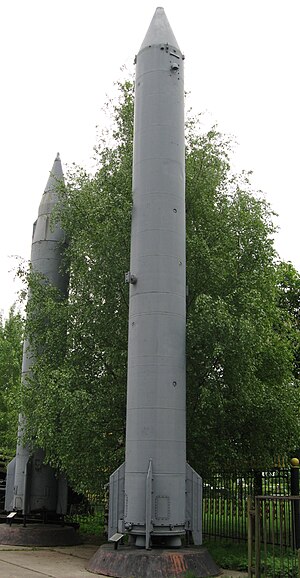| R-21 (NATO reporting name: SS-N-5 'Sark'/'Serb') | |
|---|---|
 | |
| Type | submarine-launched ballistic missile |
| Place of origin | Soviet Union |
| Service history | |
| In service | 15 May 1963 until 1991 |
| Used by | Soviet Union |
| Production history | |
| Designer | Makeyev Rocket Design Bureau |
| Specifications | |
| Mass | 16.5 t (16.2 long tons; 18.2 short tons)[1] |
| Length | 13.0 m (42 ft 8 in)[1] |
| Diameter | 1.2 m (47 in)[1] |
| Warhead | single nuclear |
| Blast yield | 800kt or 1Mt[1] |
| Engine | liquid-fuel rocket, single stage |
Operational range | 1,300 km (700 nmi) upgraded to 1,650 km (890 nmi)[1] |
Guidance system | inertial[1] |
| Accuracy | 2.8 km CEP |
Launch platform | Golf II-class, Hotel II-class submarines |
The R-21 (Russian: Р-21; NATO: SS-N-5 'Sark/Serb'; GRAU: 4K55) was a submarine-launched ballistic missile in service with the Soviet Union between 1963 and 1989. It was the first Soviet nuclear missile that could be launched from a submerged submarine, and also had twice the range of earlier missiles. It replaced the R-11FM and R-13 (SS-N-4) on many Golf and Hotel-class submarines, and was in turn superseded by the R-27 (SS-N-6 'Serb') missile carried by Yankee-class submarines.